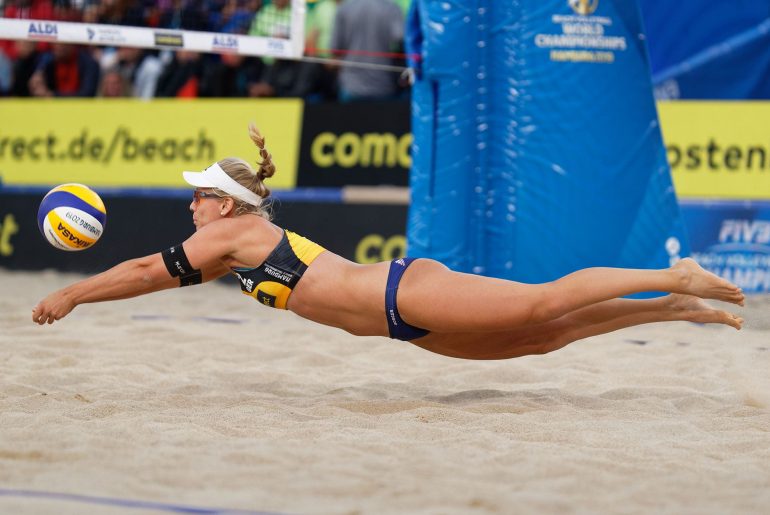How to play beach volleyball – rules of the game
From fun on the beach to an Olympic discipline: Beach volleyball (in German beach volleyball) has developed into a popular competitive sport worldwide in a relatively short time. This special variant of the volleyball game originated in the USA around 1920 based on a game that was popular on Waikīkī Beach in Hawaii.
This variant of indoor volleyball soon spread to Santa Monica and other beaches in California, as well as the Brazilian beaches of Copacabana and Ipanema. What initially seemed just casual entertainment quickly turned professional. The beach clubs, their organized leisure activities for members and competitions between the beach clubs soon led to official beach volleyball competitions. In Europe, too, the triumph of this sport from about 1930 could not be stopped. However, the first official beach volleyball tournaments in Germany did not take place until 1989 and the first European championships in 1993.
Beach volleyball has been one of the disciplines of the Summer Olympics since 1996 and there have been professional world championships since 1997. In the beginning, of course, those nations with lots of beaches and sand, such as the USA and Brazil, dominated this sport. However, only a short time later, nations such as Germany, China and Australia were also able to win medals in this sport.
Content and design
As with the racquet sport in the hall, two teams face each other in two opposite playing fields separated by a net. The aim of the game is to play a ball over the net into the opponent’s half of the field so that it touches the ground, or to force the opposing team to make another mistake.
Originally, these teams consisted of six players per team, just like in indoor volleyball. The two-player style of play that is common today is attributed to an incident in which a beach volleyball organizer waited in vain for some of his teammates to appear.
Field and net
The beach volleyball court is rectangular, measures 16 by 8 meters and must be completely covered with sand. Each team plays in one half of the field measuring 8 by 8 metres. There is no center line and therefore no penalty points when a player enters the opponent’s half of the field. But the opposing team must not be disturbed by this. There is a three-metre free zone of at least three meters outside the edge of the touchline. A net is stretched in the middle of the playing field, which is 2.43 meters high for men and 2.24 meters for women. The height of the upper edge is measured here. Antennas are located at the ends of the network.
Players and apparel
The beach volleyball team consists of two players in light clothing and barefoot. Men usually wear shorts and a shirt, for a long time women were only required to wear a bikini as sportswear. Since 2012, women and men can play with shorts above the knee and t-shirts with sleeves.
Ball
The beach volleyball ball has a water-repellent and soft light-colored cover, usually made of imitation leather, and a rubber bladder inside. The circumference is between 66 and 68 centimeters, the weight ranges from 260 to 280 grams. The internal pressure should be 171 to 221 millibars.
Gameplay
As this is an open-air game, weather conditions play a major role. Basically, the weather conditions must not cause any risk of injury for the players. If bad weather leads to an interruption of the game, it can be continued later on the basis of the intermediate result.
The game begins with the ball being served in the service zone over the net between the two antennas into the opposing team’s field. The service zone is behind the baseline and is laterally limited by the extension of the two sidelines. In contrast to indoor volleyball, there are no fixed playing positions. Each player can stand in any position of the field half. However, the right to serve belongs to the team that has scored a point. As long as the opposing team cannot win the rally, the same player always serves.
However, if there is an error in the order during the serve rotation, it does not count as an error for the score. There are usually side changes after every seven points played, in a deciding set after five rallies. This should compensate for any disadvantages of playing outdoors.
Ball touch and playing techniques
Each team must play the ball over the net into the opposing field at the latest on the third contact. A block already counts as the first ball contact. The two team players must take turns touching the ball. The only exceptions are immediately after a block, if the blocking player touches the ball a second time or if there is a double touch – for example from the arm to another part of a player’s body – when the ball is first touched.
In principle, the ball may be touched and played by any part of the body. When passing, the upper and lower passes are permitted. However, the ball may only be thrown straight forwards or backwards, but not to the side. Attacking feints with an open hand, as in indoor volleyball, are not allowed and even count as errors. The usual playing technique is the so-called digging and there are special serving and passing techniques for beach volleyball, such as touching the ball with your knuckles (pokeshot).
In defense there are also strict rules for the use of hands and fingers. The ball must always be hit and must not be touched, caught or thrown for a long time. A pass from the fingers or fingertips, as in indoor volleyball, is often whistled off as too “hard” by the referee. For example, in the case of a “hard attack hit”, it is allowed to hold the hands cupped to the ball, the arms must be stretched. However, a serve never counts as a hard attack hit. A so-called lob, a ball placed with the open hand as in indoor volleyball, is prohibited in beach volleyball.
Points counting
If a team fails to return the ball after the third contact or if the ball falls to the ground, the opponent gets a point. According to the so-called rally point system, a team can score points both on their own serve and on an opponent’s serve. A match lasts for two winning sets, requiring 21 points and a margin of at least two points over the opponent to win. If there is a tie, 15 points must be achieved in the eventual third set (tiebreak).
Each team is entitled to a time-out for each set, which they can choose freely. After 21 points, there is usually a technical time-out of 30 seconds, but not in a third set. A short break is also allowed for cleaning sunglasses.
Game tactics
In professional beach volleyball, one player acts primarily as a blocker and the other takes over the acceptance. Since no instructions from a trainer are allowed in the game, a special communication technique has developed in beach volleyball. The players on a team communicate using individual hand signals to work out their strategy.
Advantages
- Beach volleyball stands for outdoor exercise and is therefore already considered healthy.
- As a leisure activity, beach volleyball is still very popular as a hobby and can be played by all age groups outside of the competition rules.
- The rules of the game are simple and can easily be adapted to the current circumstances – more than just two players, for example a carpet pole instead of a net.
- Beach volleyball includes a lot of different movement sequences, requires a bit of fitness and therefore trains the entire body in a playful way.
- Since a ball can be played with any part of the body, a lot of fun and action is guaranteed.
- When playing in the sand away from competitive ambitions, the risk of injury is relatively low, even for inexperienced players.
Disadvantages
- Beach volleyball requires good physical preparation with strength and endurance training for everyone who wants to play this sport more seriously.
- In order to prevent the risk of injury, the playing techniques must also be learned correctly. The ankles can also be overstrained, especially if the preliminary conditioning training is missing.
- Fingers and hands are prone to injury here, so you should also train and stretch in advance. There is also special medical tape for the fingers.
- For those who want to practice this sport more intensively, it can’t be that easy to find suitable playing and training areas. This sport is practiced outdoors and on the sand, making it more difficult to train in Central Europe than, say, in Hawaii.
- It is also not possible to hold tournaments everywhere, since Central Europe is more susceptible to unpredictable weather and the resulting game interruptions, even in summer.
Is beach volleyball an Olympic sport?
Yes
Can you kick the ball in beach volleyball?
You might be wondering, can I kick in beach volleyball too? The answer is yes, the rules are the same for beach volleyball as indoor when it comes to kicking.
How did bikinis become the uniform for women’s beach volleyball?
“You’re not wearing more clothing in really hot weather; getting sand stuck in places is not fun. But I totally respect other people wanting to be more covered if that’s what makes them more comfortable.”
What kind of swimsuits do women’s beach volleyball players wear?
As a pro athlete, everyone has a different comfort level with either a bikini or one-piece bathing suit.





